Geotimes

Travels
in Geology January
2004
America's garden island
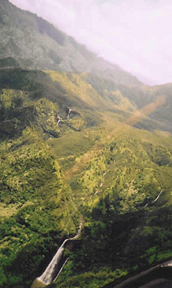 As the
cold, dark days of January set in, particularly across the Northeastern United
States, you may find yourself wanting to be somewhere else — somewhere
with 80-degree days, lots of sunshine and lush scenery. As I write this, it's
22 degrees and snowing a little bit here in northern Virginia. In the meantime,
the Kauai Visitor's Bureau flashes the current temperature
— 70 degrees at 8:28 A.M. local time. It's going to be sunny and 79 today.
Sigh.
As the
cold, dark days of January set in, particularly across the Northeastern United
States, you may find yourself wanting to be somewhere else — somewhere
with 80-degree days, lots of sunshine and lush scenery. As I write this, it's
22 degrees and snowing a little bit here in northern Virginia. In the meantime,
the Kauai Visitor's Bureau flashes the current temperature
— 70 degrees at 8:28 A.M. local time. It's going to be sunny and 79 today.
Sigh.
Rainfall varies tremendously
throughout Kauai. The interior is a tropical jungle, with one valley (Waialeale)
recording an average of 444 inches of rain per year. In contrast, the south
side of the island gets about 35 inches of rain per year.
Lucky for us this is a great season to fly to Hawaii. Every day in my email
inbox I find special offers to fly to Kauai for much less than it cost me when
I visited there last May. Also lucky for us, this is the prime season for whale-watching
(humpback whales spend December to April in the Hawaiian waters). But regardless
of the time of year, Kauai is a remarkable place to learn about geology.
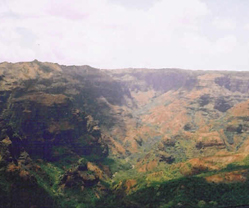 The oldest
major island of the Hawaiian chain, Kauai is 5 million years old. The last known
eruption on the island occurred about 400,000 years ago, compared to the youngest
Hawaiian island — the Big Island — which is erupting as I write. The
533-square-mile island is home to striking ancient lava-flow cliffs and erosional
valleys, the longest white sand beach in the islands, a desert, canyons, lava
pillows and ancient landslides offshore, tropical forests, coral reefs and lots
of waterfalls.
The oldest
major island of the Hawaiian chain, Kauai is 5 million years old. The last known
eruption on the island occurred about 400,000 years ago, compared to the youngest
Hawaiian island — the Big Island — which is erupting as I write. The
533-square-mile island is home to striking ancient lava-flow cliffs and erosional
valleys, the longest white sand beach in the islands, a desert, canyons, lava
pillows and ancient landslides offshore, tropical forests, coral reefs and lots
of waterfalls.
Waimea Canyon, carved out by the rainfall
coming off Waialeale, is often called the "Grand Canyon of the Pacific,"
with its red lava ridges towering more than 2,500 feet above the canyon floor.
Called the Garden Island because of its lush greenery, the interior of the
island Kauai is an outdoor-lovers paradise. Only 10 percent of the island is
accessible by roads, which means hiking, biking, horseback riding, kayaking,
ATV-ing, sailing or flying are the best options to reach the rest of this remote
island.
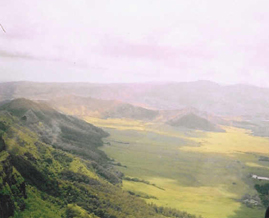 Finding
a resort, a hotel, a condominium or a campsite is also excessively easy in Kauai.
A car rental is pretty much a necessity, but as long as you reserve ahead, you
won't have a problem. Although tourism is the number one business of Kauai as
it is on the other islands of Hawaii, a visit to Kauai is far different from
the bustling beaches of Maui or Oahu. It's a visit to the Hawaii of yesteryear
— a natural and wild place that offers a far slower pace of life.
Finding
a resort, a hotel, a condominium or a campsite is also excessively easy in Kauai.
A car rental is pretty much a necessity, but as long as you reserve ahead, you
won't have a problem. Although tourism is the number one business of Kauai as
it is on the other islands of Hawaii, a visit to Kauai is far different from
the bustling beaches of Maui or Oahu. It's a visit to the Hawaii of yesteryear
— a natural and wild place that offers a far slower pace of life.
The first must-see on Kauai is the Na Pali Coast. Located on the northwest coast
of Kauai, the 17-mile-long coast rises several thousand feet above the sea.
Waterfalls cascade hundreds of feet through the knife-blade-sharp cliffs. Along
the edges you can see agricultural terraces where ancient Hawaiians once farmed.
You may recognize the scene at right
from one of the many movies filmed on Kauai, such as Jurassic
Park, South Pacific and Six Days, Seven Nights.
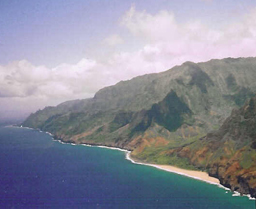 The Na
Pali cliffs are composed of basaltic lava flows that formed rather quickly.
Some geologists have speculated that part of the reason for the sharpness of
the cliffs is that they are remnants of large landslides (geologists have found
evidence of ancient landslides off the northwest coast). Others speculate that
the cliffs were formed merely by erosion from the rough waves of the Pacific
Ocean.
The Na
Pali cliffs are composed of basaltic lava flows that formed rather quickly.
Some geologists have speculated that part of the reason for the sharpness of
the cliffs is that they are remnants of large landslides (geologists have found
evidence of ancient landslides off the northwest coast). Others speculate that
the cliffs were formed merely by erosion from the rough waves of the Pacific
Ocean.
The 17-mile-long Na Pali coastline is
a must-see on a visit to Kauai.
Getting to the coast, however, is no easy task: With no roads near the coast,
it is only accessible via sea, air or foot. Despite the challenge to get there,
it is well worth the effort.
On my trip to the Na Pali Coast, I took a zodiac boat tour, which was not for
the faint of heart or faint of body, even if it was significantly easier than
hiking. It was a grueling 3-hour roller-coaster boat ride to a park along the
coast where we stopped to snorkel and explore an archaeological site. By the
end of the trip, I was thoroughly exhausted and had bloody knuckles from holding
onto the ropes on the boat so strenuously, but I'd do it again in a heartbeat.
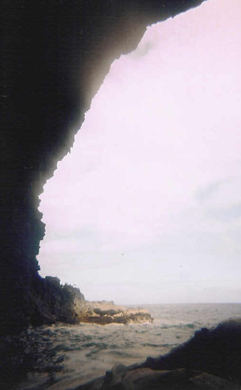 Along
the way, a humpback whale calf and its mother swam alongside our boat, spinner
dolphins happily performed for us, and we actually entered a roofless ancient
lava tube sea cave. Landslide or not, looking at the many sea caves carved out
of the lava cliffs, it is easy to see exactly the effects that the rough waves
have on the coast.
Along
the way, a humpback whale calf and its mother swam alongside our boat, spinner
dolphins happily performed for us, and we actually entered a roofless ancient
lava tube sea cave. Landslide or not, looking at the many sea caves carved out
of the lava cliffs, it is easy to see exactly the effects that the rough waves
have on the coast.
Our guide, a native Hawaiian man wearing little more than a sarong, told us
about the geology, ecology and biology of the cliffs, as well as some of the
myths explaining the interesting cliffs and waterfalls we saw. The cliffs are
sacred to native Hawaiians, and according to local legend, a mysterious mana
protects the cliffs. Moreover, legend has it that if you take a volcanic rock
off of Kauai, as with the other Hawaiian islands, bad luck will follow you everywhere
until that rock is returned — we were even warned about this upon arrival
at the airport.
The Na Pali coastline is famous for its
incredible scenery, including sea caves such as this one formed from the rough
waves of the Pacific slamming into the porous lava.
If you're not quite up for the zodiac ride, catamarans and sailboats also tour
the coast. And if you're hardier than me, try kayaking it. Many companies offer
kayak rentals and guides to accompany you if you're a novice. But perhaps the
best way to see the geology up close and personal is to hike it or go by horseback.
There are trails that begin at both the north and south ends of the coastline.
Some are shorter 4-mile hikes to waterfalls (relief is several thousand feet),
and some run the entire length of the coastline. Brochures from any of the towns
along the way to the coast will tell you more about the geology and ecology
you'll encounter on the trails.
No matter what kind of outdoor adventure makes you happy, even golfing on lava
flows or relaxing on a volcanic beach, Kauai has abundant resources to match
your interests. When you stop off the airplane in Lihue, take a deep breath
and let aloha take your worries away. Then go geo-exploring.
Megan Sever
Links:
Geology
of Kauai
Kauai
at HawaiiWeb
Kauai
Field Trip
Kauai
Visitor's Bureau
Movies
in Kauai (Coconut Palace)
Discover
Kauai
Kauai
Nature Tours
Read
more Travels
in Geology.
Back to top
 As the
cold, dark days of January set in, particularly across the Northeastern United
States, you may find yourself wanting to be somewhere else — somewhere
with 80-degree days, lots of sunshine and lush scenery. As I write this, it's
22 degrees and snowing a little bit here in northern Virginia. In the meantime,
the Kauai Visitor's Bureau flashes the current temperature
— 70 degrees at 8:28 A.M. local time. It's going to be sunny and 79 today.
Sigh.
As the
cold, dark days of January set in, particularly across the Northeastern United
States, you may find yourself wanting to be somewhere else — somewhere
with 80-degree days, lots of sunshine and lush scenery. As I write this, it's
22 degrees and snowing a little bit here in northern Virginia. In the meantime,
the Kauai Visitor's Bureau flashes the current temperature
— 70 degrees at 8:28 A.M. local time. It's going to be sunny and 79 today.
Sigh.
 The oldest
major island of the Hawaiian chain, Kauai is 5 million years old. The last known
eruption on the island occurred about 400,000 years ago, compared to the youngest
Hawaiian island — the Big Island — which is erupting as I write. The
533-square-mile island is home to striking ancient lava-flow cliffs and erosional
valleys, the longest white sand beach in the islands, a desert, canyons, lava
pillows and ancient landslides offshore, tropical forests, coral reefs and lots
of waterfalls.
The oldest
major island of the Hawaiian chain, Kauai is 5 million years old. The last known
eruption on the island occurred about 400,000 years ago, compared to the youngest
Hawaiian island — the Big Island — which is erupting as I write. The
533-square-mile island is home to striking ancient lava-flow cliffs and erosional
valleys, the longest white sand beach in the islands, a desert, canyons, lava
pillows and ancient landslides offshore, tropical forests, coral reefs and lots
of waterfalls. Finding
a resort, a hotel, a condominium or a campsite is also excessively easy in Kauai.
A car rental is pretty much a necessity, but as long as you reserve ahead, you
won't have a problem. Although tourism is the number one business of Kauai as
it is on the other islands of Hawaii, a visit to Kauai is far different from
the bustling beaches of Maui or Oahu. It's a visit to the Hawaii of yesteryear
— a natural and wild place that offers a far slower pace of life.
Finding
a resort, a hotel, a condominium or a campsite is also excessively easy in Kauai.
A car rental is pretty much a necessity, but as long as you reserve ahead, you
won't have a problem. Although tourism is the number one business of Kauai as
it is on the other islands of Hawaii, a visit to Kauai is far different from
the bustling beaches of Maui or Oahu. It's a visit to the Hawaii of yesteryear
— a natural and wild place that offers a far slower pace of life. The Na
Pali cliffs are composed of basaltic lava flows that formed rather quickly.
Some geologists have speculated that part of the reason for the sharpness of
the cliffs is that they are remnants of large landslides (geologists have found
evidence of ancient landslides off the northwest coast). Others speculate that
the cliffs were formed merely by erosion from the rough waves of the Pacific
Ocean.
The Na
Pali cliffs are composed of basaltic lava flows that formed rather quickly.
Some geologists have speculated that part of the reason for the sharpness of
the cliffs is that they are remnants of large landslides (geologists have found
evidence of ancient landslides off the northwest coast). Others speculate that
the cliffs were formed merely by erosion from the rough waves of the Pacific
Ocean.  Along
the way, a humpback whale calf and its mother swam alongside our boat, spinner
dolphins happily performed for us, and we actually entered a roofless ancient
lava tube sea cave. Landslide or not, looking at the many sea caves carved out
of the lava cliffs, it is easy to see exactly the effects that the rough waves
have on the coast.
Along
the way, a humpback whale calf and its mother swam alongside our boat, spinner
dolphins happily performed for us, and we actually entered a roofless ancient
lava tube sea cave. Landslide or not, looking at the many sea caves carved out
of the lava cliffs, it is easy to see exactly the effects that the rough waves
have on the coast.